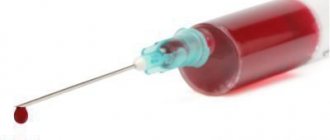Blood sampling is one of the mandatory procedures during an annual medical examination, but not all people tolerate it well. According to official statistics, about 3-4% of the planet's population shudders at the sight of blood or the realization that in the near future this liquid connective tissue will end up outside, and not inside, the body. What is the cause of this condition and is it possible to fight it?
In this article:
What is hemophobia and why is the fear of blood inherent in every person? How does the fear of blood manifest itself? Symptoms and signs of hemophobia. What is the fear of blood associated with? Which celebrities are susceptible to the fear of blood? Why do you need to get rid of the fear of blood? Techniques for treating hemophobia How to learn not to be afraid of blood
What is hemophobia and why is the fear of blood inherent in every person?
Photo by Oleg Magni: Pexels
From the ancient Greek language, the term “hemophobia” is translated as “fear of blood.” This condition is a mental disorder and is one of the 30 most common types of fears in the world. According to statistics, it affects from 200 to 400 million people of all ages.
At the same time, it is customary to distinguish between a phobia (accompanied by panic or severe discomfort) and a person’s basic instincts.
You may not be a hemophobe, but be wary or feel internal discomfort at the sight of blood.
These are normal protective mechanisms that have their origins in the distant past and are transmitted at the genetic level. It's simple: you need to make sure that you don't experience blood loss and stay healthy.
But in the case of a phobia, these body reactions are squared. As a result, multiple excessive reactions of the body occur, by which this mental disorder can be identified.
Why do people faint and are afraid of blood?
Dizziness, abdominal pain, sweaty palms, loss of vision, ringing in the ears - such symptoms may precede fainting. Many of us (especially those who are afraid of blood) have experienced neurocardiogenic syncope (or simply fainting). This phenomenon in itself is not dangerous, but an unexpected fall can cause serious injury. Curiosity figured out how fainting works. T&P publishes a retelling.
Loss of consciousness is always associated with insufficient supply of blood (and with it oxygen) to the brain due to a sharp change in blood pressure.
For example, in past centuries, women often fainted because of corsets, which simply interfered with proper breathing. The change in pressure in this case is associated with the work of the vagus nerve, which stretches from the brain to the heart, lungs and abdominal cavity and regulates our parasympathetic system. The vagus nerve releases the neurotransmitter acetylcholine, which slows the heart rate. For example, deep breathing during yoga aims to increase parasympathetic activity to achieve a relaxed state. However, slowing down the heart rate may be too fast and cause a large drop in pressure. Increased parasympathetic activity also reduces vascular resistance to blood flow, which is controlled by the sympathetic nervous system. As a result, blood circulates more slowly, is retained in peripheral tissues instead of reaching the brain, and fainting occurs.
But what are the causes of disturbances in the functioning of the vagus nerve? Most often it is psychological stress. A classic example is loss of consciousness from the sight of blood. First, fear increases the activity of the sympathetic nervous system, which causes an increase in heart rate. Then
The parasympathetic system tries to reduce anxiety by slowing the heartbeat, but it can overdo it, causing loss of consciousness.
Some experts believe that short-term loss of consciousness may be a specific protective mechanism. If the fear of tests and injections is latently associated with potential blood loss, then the body, by bringing the body into a horizontal position with the help of fainting, may try to prevent greater blood loss and simplify its task of supplying the brain with oxygen.
How to avoid loss of consciousness?
- Do medical procedures while lying down.
- If you feel weak, bend your knees or raise them.
- Tighten the muscles of your arms and legs.
- Drink enough water to maintain a high blood volume.
- Remember that regular fainting (as opposed to occasional fainting at the sight of blood) is a reason to consult a doctor.
Where can I study on the topic #brain?
Well
Brain Chemistry
As you type
Well
Structure and functioning of the brain
As you type
Well
Neurobiology
September 1, 2021 – June 1, 2021
Where can you study on the topic #biology?
Seminar
Neuroprosthetics: who gets electrodes implanted into the brain and why? - public program “Future Tense”
July 31, 2021 at 07:30 pm
Seminar
Alexander Markov. We and our genes. Genetics and human psychology
17 Sep 2021 at 19:00
Read us on Facebook, , Twitter, Instagram, Telegram (@tandp_ru) and Yandex.Zen.
How does the fear of blood manifest itself?
Agree, seeing a pool of blood in person, you will definitely feel discomfort caused by the reluctance to see the creature (human or animal) from which it flowed. Another reason why you will bypass such a find lies in the likelihood of a crime. You probably don't want to be the next victim. And that's okay.
What is hemophobia?
Hemophobes are afraid of blood not only in large quantities. They are frightened, among other things, by the very realization that the injury will be followed by a physical manifestation of this tissue. Cutting your finger, getting an injection, getting your blood tested is a real stress for people suffering from hemophobia.
Symptoms and signs of hemophobia
There are a number of signs characteristic of the behavior of hemophobes. So, the following manifestations of this mental disorder are common:
- sudden attacks of tachycardia;
- lowering blood pressure;
- pulsation in the temporal zone;
- dizziness;
- pale skin;
- tremor of the limbs;
- dilated pupils;
- increased nervousness;
- breathing problems;
- fainting states.
A sharp decrease in blood pressure in this case is a protective mechanism. It slows down blood circulation and, accordingly, reduces the risk of blood loss. The same factor leads to fainting, since insufficient blood enters the brain, briefly “switching off” it.
What is the fear of blood associated with?
Fear of injections and any medical procedures that may be accompanied by blood sampling, injections, or surgery is one of the few components of hemophobia. The basis of this fear is the possible pain that can accompany any of the listed manipulations.
Factors that provoke hemophobia include:
- history of phobia;
Giphy
- traumatic experience (seeing or experiencing an accident can provoke a fear of blood at any age, but this problem is especially relevant among children and impressionable people);
- negative impact on the psyche (watching “bloody” films, scenes of violence, crime chronicles).
In severe cases of hemophobia, you are afraid of death, which you consider to be a logical consequence of blood loss. The point is that this fear is too exaggerated and increased in scale: mentally you understand that you will not die if you submit this liquid connective tissue for analysis, but in fact you reject the arguments of reason and lose control over somatics.
Which celebrities have a fear of blood?
Sometimes hemophobia develops in adults and mentally balanced people against the background of certain health problems in the environment. For example, Nicholas II was afraid of the sight of blood because of a hereditary disease of his son Alexei. The boy had hemophilia - a blood clotting disorder that could have caused his sudden death from hemorrhage in the brain and other organs.
A modern celebrity, the star of the TV series “Streets of Broken Lights,” Anastasia Melnikova, also “earned” hemophobia due to her environment, but for a different reason. The father of the future actress, an oncologist surgeon, somehow decided to introduce his daughter to the work dynasty and brought her to the operating room. While the experiment was a success with Melnikova’s brother, it wasn’t for her. The girl lost consciousness at the sight of the syringe and blood.
Hemophobia (fear of blood) causes
The causes of hemophobia are psychological. Previously it was believed that this fear had a genetic predisposition, but studies on identical twins showed that the root cause of the phobia is society, as well as traumatic events, but not genetics. Therefore, in principle, this problem can be solved, you just need to find a good psychotherapist.
Hemophobia is divided into different groups. This unit is built on the reasons that cause a person’s negative reaction:
- fear of seeing someone else's blood;
- fear of seeing your blood;
- fear of seeing blood in animals, fish, people;
- fear of seeing blood at all.
Hemophobes, aware of their fear, avoid the services of traditional medicine and use herbs and meditation in treatment. Some people refuse to eat meat and eventually turn into complete vegetarians.
Why is a hemophobe afraid? The reason may be an alleged injury that poses a danger to life and health, or fear of a repeat of previous poor health when donating blood. Fear can come from childhood, when your mother scolded you for minor wounds or cuts.
The fear of blood due to war is one of the real causes of this phobia, which often affects both children and adults. The media contribute to this by openly broadcasting news channels from war zones, thereby provoking the development of hidden forms of phobias.
Often, the state of panic caused by hemophobia is attributed to a pain reaction accompanied by the appearance of bleeding, but not the fear of blood itself. Or often this behavior is attributed to a state of stress that is experienced when seeing other people’s injuries and injuries. It is worth noting that the majority of those suffering from severe forms of this phobia, who do not encounter bleeding in everyday life, reduce their source of fear to zero.
Why you need to get rid of the fear of blood
No, no one will force you to watch horror films and scenes of cruelty if you love cartoons and comedies with a happy ending. But objectively, inadequate fear and the accompanying symptoms reduce the quality of your life.
You can’t go to the doctor “without incident”, you often feel bad (because your fantasy “inflates” a whole puddle of blood from any ketchup stain), and so on.
Sometimes you categorically refuse to make contact with people who want to provide you with simple medical assistance. For example, a bleeding scratch on your knee in your thoughts becomes overgrown with the prospect of amputation, so you distance yourself from those around you who intend to treat the wound with peroxide.
In cases where the fear of blood is not associated with defense mechanisms, it must be gotten rid of at least in order to be able to live fully and enjoy life.
The reason for the development of hemophobia
The root of the fear of the sight of blood lies deep in the human psyche. Therefore, no amount of persuasion to stop being afraid helps. In order to change a condition, you need to understand the reasons for its occurrence. The training “System-vector psychology” by Yuri Burlan reveals the unconscious mechanisms of our psyche. With its help, you can look into the darkest corners of the soul to understand where our fears and obsessive thoughts come from.
People with phobias have a lot in common. These are emotional people who often have wet eyes. They are sensitive to beauty and aesthetics. They love cinema, theater, art. They try to avoid sad emotions that lead to strong feelings, for example, films about war. People who have a visual vector are capable of a wide range of emotions: from worrying about themselves to deep and sincere love and care for others.
The very first, basic emotion that has developed evolutionarily in people with a visual vector is the fear of death. The root of all phobias is fear for your life. That's why the sight of blood makes me feel so bad. After all, this is the main reason for the interruption of life: death from wounds, bites, and so on. This is an anchor that subconsciously causes panic fear and all subsequent symptoms. Ignorance of the laws of the psyche does not exempt one from the consequences.
Treatment techniques for hemophobia
Successful treatment of any phobia is possible if it is accepted. That is, initially you should not look for arguments in favor of your fear, but agree with its irrationality.
Photo by Edward Jenner from Pexels
You can then resort to forms of treatment such as:
- consultation - contact a psychiatrist who will help identify the root cause of the phobia and develop a treatment regimen;
- hypnosis - a good specialist will help you on a subconscious level to reconsider your attitude towards a situation that leads to paralyzing fear, and based on a new attitude towards the problem, you will be able to get rid of it;
- Cognitive-behavioral correction – involves blocking fear at the hormonal level, which promotes psychological and physical control. In practice, this implies systematic contact with the subject of fear in order to form and consolidate positive reactions to it.
Sedatives prescribed by a specialist will be an optional, but auxiliary factor in recovery.
How to get rid of hemophobia?
Drug therapy will not bring the expected effect without the help of a highly qualified psychologist or psychotherapist
Treatment of hemophobia is complex and allows you to solve several problems at once:
- eliminate fear of blood;
- correct destructive behavioral line (avoidance);
- eliminate depressive and anxious emotional disorders resulting from prolonged refusal of medical care.
Therapy in this case includes:
- taking medications;
- psychotherapy.
Drug treatment
Drug treatment is prescribed when, against the background of a phobia, emotional disorders have developed, accompanied by mental exhaustion. Patients are recommended:
- sedatives that suppress anxiety and fear (prescribed in the initial stages of treatment);
- hypnotics – sleeping pills that normalize sleep/wake patterns;
- tranquilizers - anxiolytics with a calming effect (prescribed for frequent and severe attacks of fear);
- antidepressants (prescribed in small dosages in the presence of depressive conditions).
Medications used to treat hemophobia are prescribed only by a doctor. Self-medication in this case is unacceptable, as it can significantly worsen the general condition of the patient. Prescribed medications must be taken in recommended doses and according to a specific schedule under the supervision of a specialist.
If fear of blood is a symptom of another mental disorder, treatment is directed toward eliminating the underlying cause.
Psychotherapy
One of the effective methods of combating hemophobia is psychotherapy to identify the causes and control fears.
Psychotherapeutic effects begin after drug treatment. Patients may be recommended:
- Hypnosuggestive therapy. It is used in the treatment of patients who are unable to work with a phobia on a conscious level. The essence of treatment is to change the attitude towards the object of fear on a subconscious level. As a rule, five sessions are enough to get rid of the problem.
- Cognitive-behavioral approach. It implies a person’s conscious “acquaintance” with the object of his fear. The method is based on teaching techniques to combat fears by independently correcting destructive thoughts that generate anxiety. Treatment continues for seven to ten sessions.
- Psychoanalysis. It is used in the treatment of people whose illness has developed against the background of one or another psychological trauma. As part of the treatment, the patient re-experiences the moment that traumatized him, processes his experiences and achieves harmony in the area of conflict. Therapy continues for at least ten sessions.
- Work in therapeutic groups. It is used after the main psychotherapeutic sessions in order to consolidate and maintain the achieved results (within the sessions, the phobia of each group member is worked on in turn). It is prescribed to people who have overcome fear, but are not confident in their own abilities.
Mild hemophobia, accompanied only by fear and tension, can be cured in one or two sessions conducted by a psychotherapist.
How to learn not to be afraid of blood
Since blood, with rare exceptions, is an integral part of living beings, it is normal to perceive its appearance, if not a mandatory, then a desirable skill. If you have hemophobia, you can accustom yourself to adequate mental reactions to the sight of this tissue:
Photo by Anna Shvets: Pexels
- control your breathing (alternating deep breaths and exhalations will help stabilize your heartbeat);
- squat or jump up the moment you feel yourself starting to lose consciousness. This way you will speed up blood circulation and, accordingly, blood supply to the brain.
To prevent blood phobia, you can try to eliminate factors that cause panic associations with the subject of fear (don’t look at cruelty, don’t listen to crime news).
Fear of the sight of blood, as it is called
This fear is called hemophobia. This term was introduced by the American psychiatrist J. Vaenberg in 1972. As practice shows, a person can be put into an anxious state by:
- blood tests, injections, vaccinations;
- scratches and cuts;
- bleeding, wounds;
- bloody scenes in movies or pictures.
It does not matter whether the person himself was injured or whether it happened to someone else. People with hemophobia can be equally unhelpful in helping themselves or others. It is very dangerous. In some cases, penalties are provided. For example, if you fail to provide assistance to a victim of an accident. The fear of the sight of blood prevents many from choosing a profession, in particular, studying at a medical institute.
Manifestations of hemophobia in humans
Symptoms may vary:
- panic attacks;
- pale face;
- severe dizziness;
- nausea;
- cardiopalmus;
- fainting.
I know about these conditions firsthand. At school, during vaccination, I spent the entire next lesson in the nurse's office. Even before the injection, I turned all pale, then I felt really bad, they pumped me out with ammonia on the couch. In adult life, little has changed. It was especially difficult to go through donating blood. I was turning pale and feeling very dizzy. The doctor could not take blood from me, as it simply did not flow due to the dropped pressure. As a result, instead of 3 minutes, like for ordinary people, for me this torment lasted at least 15 minutes. They pierced both my arms in the hope of obtaining material for analysis. The memories alone give me goosebumps. You can read doctor's notes about patients with phobias here.
The obsessive fear did not go away from persuading myself, from accompanying loved ones. Therefore, I never stopped looking for the causes of these conditions. The answers were found during the training “System-vector psychology” by Yuri Burlan.










